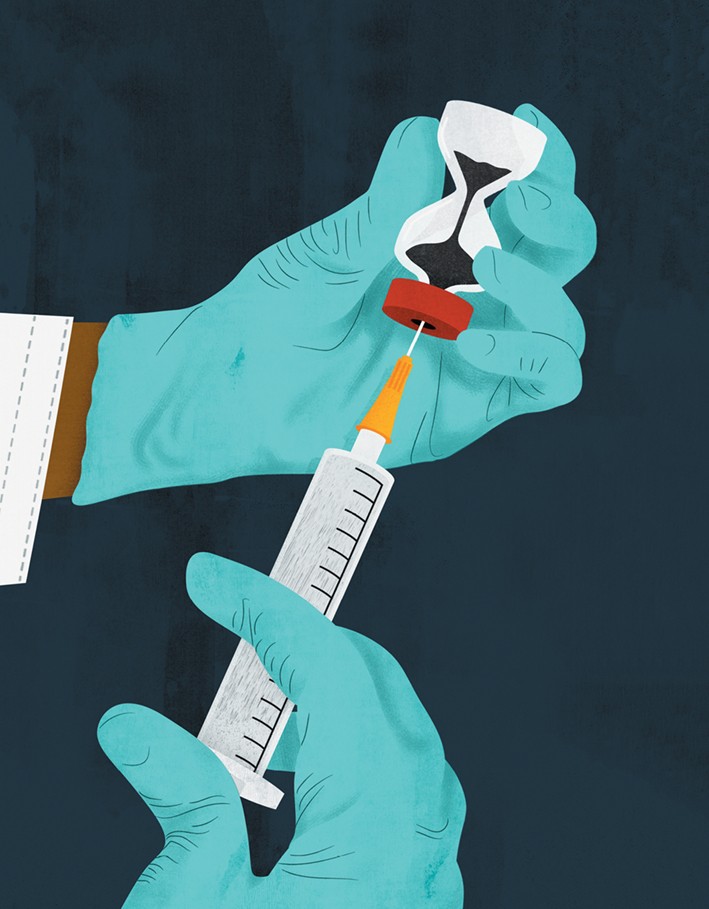“If you look at the growth of R&D globally, Asia is an area where it continues to increase, as opposed to nearly level funding as in the United States,” says Jerome Kim, the director-general of the International Vaccine Institute (IVI) based in Seoul, South Korea.
With the global vaccine market expected to exceed US$15 billion a year by 2025, research aimed at developing new vaccine targets, and cheap and effective versions of existing vaccines, is essential if suppliers are to meet market demand.
Asia is shaping up to be a vaccine powerhouse. The signs are there in funding levels, and combined with Asian governments’ interest in biotechnology, and a highly skilled, highly educated workforce, pharma giants are looking east. Indeed, there is already a focus in Asia on making what Kim refers to as ‘premium vaccines’ such as rotavirus, human papillomavirus (HPV) and pneumococcal conjugate.

© Mitch Blunt/Ikon Images/Getty
Changes
Ken Ishii, director of the Center for Vaccine and Adjuvant Research (CVAR) at the National Institute of Biomedical Innovation, Health and Nutrition (NIBIOHN) in Japan, believes that for countries like Japan, China or Korea the main challenge is now figuring out “how to catch-up, and how to lead, in global vaccine development”.
He says that for many Asian countries the lack of designated grant systems, good start-up companies and strong regulatory agencies like the US FDA has made it difficult to take vaccines from the bench to the market.
But this is changing. “Asian governments and capital funds are trying to support start-up companies for innovative R&D, including vaccines,” he says. He points to the public-private partnerships Global Health Innovative Technology (GHIT) and Research Investment in Global Health Technology (RIGHT) funds, as a way of leveraging investment from private companies.
Jerome Kim flags another change. Until recently, Asian companies (excluding those from India) typically hadn’t been aggressive in pursuing prequalification – a stamp of approval from the World Health Organization (WHO) that allows their vaccine to be placed on the UN and the Global Alliance for Vaccines and Immunization (GAVI) purchasing programmes. But now, Kim and the IVI are pursuing prequalification for oral cholera vaccines from India and South Korea, and are hopeful that their efforts with SK Biosciences (South Korea) and BioFarma (Indonesia), will lead to prequalification of a typhoid conjugate vaccine.
Shan Lu, a professor at the University of Massachusetts Medical School and a past president of the International Society for Vaccines, notes that Chinese companies are also in pursuit of prequalification.
Contributing to global health
Lu stresses the importance of east Asia contributing to universal vaccination coverage. “If we rely on the major pharmaceutical companies in Europe and North America to develop vaccines it will stretch limited resources from those countries,” he notes. Moreover, some diseases of regional importance for Asia, may not be of interest for western pharmaceutical companies if they are high risk, low return prospects.
Lu points to the development of vaccines against enterovirus (EV71) by several Chinese companies as a success story of Asian vaccine research. EV71 is the cause of hand, foot and mouth disease, which, since the 1990s, has had multiple epidemics with high fatality rates in Asia but until China stepped in, a vaccine had not been pursued by major pharmaceutical companies.
International collaboration
Encouraging a free flow of people and information is essential to overcome these challenges. Kim emphasizes the need for Asian governments to work together to tackle challenging diseases, such as ‘the big 3’ — HIV, TB and malaria — and “develop a programme that is systematic and collaborative with another Asian country”.
Ishii remarks that in some ways Asia is in a similar position politically and geographically to European countries before the formation of the European Union. “Fifty years ago no-one would have imagined Germans, Spanish and French would be talking about science, in English, in Italy,” he says.
Meanwhile, the fragmented nature of the regulatory bodies — similar to pre-EU Europe — means there are roadblocks in obtaining approval for vaccines in multiple countries, and it is a very expensive process. Kim notes that a common approval mechanism for Asia could help local companies jump those regulatory hurdles.
Asian researchers come together when outbreaks of emerging infectious diseases such as Severe acute respiratory syndrome (SARS) and Middle East respiratory syndrome (MERS) arise, but research leaders within the region are trying to encourage closer collaboration at less stressful times. A series of conferences, including the International Society of Vaccines Asia Meeting, held first in Shanghai, China, then Osaka, Japan and later this year in Seoul, South Korea, are intended to facilitate knowledge sharing and exchange of people and resources.


 Focal Point on Vaccine Research in Asia
Focal Point on Vaccine Research in Asia